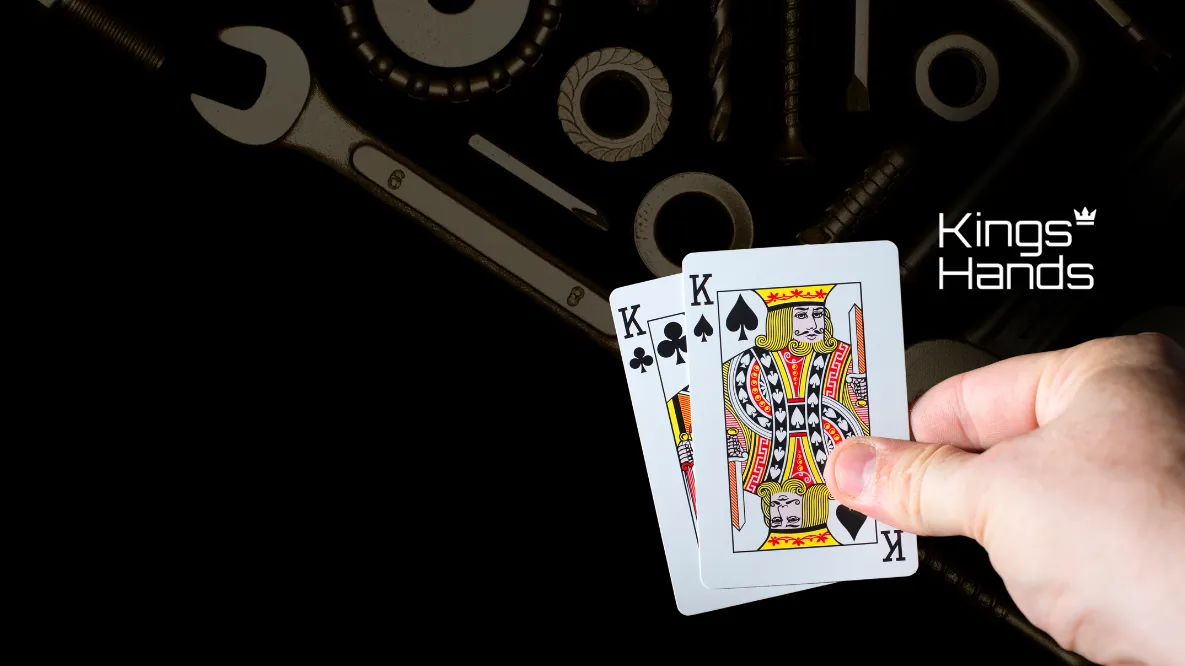One of the first things you should learn when playing poker is what cards will improve your hand, and what the likelihood is of you hitting one of those cards. Understanding these two concepts allows you to gain a better oversight of how a hand will play out across later streets, and allows you to make better decisions when facing bets from your opponents.
In this article, we’ll be looking at how you count your outs, how to calculate the chance that you’ll hit one of your outs, as well as a quick and easy way to do those calculations at the table. So, let’s jump right in!
How To Count Your Outs
Being able to count your outs relies on a familiarity with the deck. It may seem simple, but part of fully understanding poker math is having an intimate knowledge of the deck, so to cover all the bases, let’s look at the important aspects of the deck. There are 13 sets of ranked cards, with four cards of each rank – one for every suit, e.g. AcAhAdAs, which means there are 13 cards in each suit.
For those of you who are unfamiliar with the term, we’re describing an “out” as a card that will improve your hand to one that is likely best. It’s often used to refer to a hand that’s not currently winning, but as you don’t know whether or not you have the best hand, many people just use “out” as a ubiquitous term to describe any card that improves their hand.
For example, if you have AdKs on a flop of Ts7c3d, there are three aces and three kings that will improve your hand, which gives you a total of six “outs.” However, if you have Ac4c on a board of KsTh7c, a 4 would not be considered an out, as it is unlikely to improve your hand to one that’s beating your opponent’s hand.
Before we go any further, let’s take a look at the most common hands/outs combinations you’ll see when playing poker.
Hand | Hole Cards | Flop | Outs | Exact Outs |
Pocket Pair | 6c6d | KhJs8c | 2 | 6s 6h |
One Overcard | Ks5s | Td9s6h | 3 | Kd Kh Kc |
Gutshot Straight Draw | Tc9h | 7d6h2c | 4 | 8d 8h 8c 8s |
Two Pair | QhJh | QsJd7c | 4 | Qd Qc Js Jc |
One Pair | 9c7c | Kd9s3h | 5 | 9h 9d 7h 7d 7s |
Two Overcards | AsKh | Td7c4h | 6 | Ah Ad Ac Kd Kc Ks |
Three-of-a-Kind | 3c3s | Jc7s3d | 7 | 3h Jh Jd Js 7h 7d 7c |
Open-Ended Straight Draw | 5h4c | 6c7sJd | 8 | 8c 8d 8s 8h 4h 4d 4c 4s |
Flush Draw | Kh9h | Ah8h4c | 9 | Qh Jh Th 7h 6h 5h 4h 3h 2h |
Flush Draw & Gutshot Straight Draw | 8d7d | Kd5h4d | 12 | Ad Qd Jd Td 9d 6d 5d 3d 2d 6s 6h 6c |
Flush Draw & Open-Ended Straight Draw | JcTc | 9c8c4s | 15 | Ac Kc Qc 7c 6c 5c 4c 3c 2c Qd Qh Qs 7d 7s 7h |
IMPORTANT NOTE – It’s important that you don’t double-count your outs when calculating how many you have. For example, when looking at the flush draw and gutshot straight draw, you can see that there are only 12 outs rather than the 13 you get from adding the 9 flush draw outs and 4 gutshot outs. This is because, in the above example, the 6d is already used as part of the flush draw outs, leaving three sixes to be counted when considering the gutshot outs.
How To Calculate The Probability You’ll Hit Your Outs
Now that we know how to count our outs, what can we do with that information? Well, we can use our knowledge of our cards and the community cards to calculate the likelihood of us hitting one of our outs on the turn or river.
When the flop is dealt, we know 5 of the 52 cards that have been dealt – we know the two in our hand, and we know the three on the flop. This means that there are 47 possible cards that have a chance of appearing on the turn. To calculate the likelihood that we hit one of our outs, all we have to do is divide the number of outs by the number of remaining cards in the deck.
For example, we have 7h6h on a flop of Ah9h2c, and we want to know how often we’ll make our flush on the turn. We know from our work earlier that as we have two flush cards in our hand and there are two on the board, there are four flush cards removed from the deck, leaving nine possible hearts that we can hit on the turn; Kh, Qh, Jh, Th, 8h, 5h, 4h, 3h, and 2h.
So, to work out our chance of hitting a flush on the turn, we divide our 9 outs by the 47 possible cards left in the deck. 9 / 47 = 0.191, and we multiply that number by 100 to get our percentage. This means that 19.1% of the time, we’ll make our flush on the river.
IMPORTANT NOTE – While our opponents are holding cards that cannot be drawn on the turn, we do not eliminate those from our calculation.
However, what if we wanted to calculate our odds of hitting our flush by the river, what calculations do we need to do then? First, we take our calculation from the previous example, as we know that we have a 19.1% chance of making our flush on the turn. But, what if we don’t make our flush on the turn? We now know 6 of the possible 52 cards, leaving 46 unknown cards left in the deck.
We still have 9 outs, so the new calculation becomes 9 / 46 which equals 0.195, or a 19.5% chance of making our flush from the turn to the river. However, we can’t just add these two percentages together and call it a day, the calculator for that is slightly more complicated – let’s take a look.
Odds of hitting an out on the turn or river = % Turn Hit + (% River Hit * (1 – % Turn Hit))
Now, that looks complicated, but once we break it down and add in some numbers, you’ll see it’s not too bad. We’ll use our example and see what the equation comes back with.
Odds of hitting an out on the turn or river = 0.191 + (0.195 * (1 – 0.191)
Odds of hitting an out on the turn or river = 0.191 + (0.195 * 0.809)
Odds of hitting an out on the turn or river = 0.191 + 0.157
Odds of hitting an out on the turn or river = 0.348 = 34.8%
As you can see, the percentage is slightly lower than if we just added the two percentages together, and we’d have a 34.8% chance of making our flush by the river.
This calculation can be used when determining the likelihood of hitting any number of cards on the turn or river, so don’t think that you should only use it when calculating draws!
The 2/4 Rule
If the last equation seems a little bit too complicated to be doing at the table, then you’re absolutely right. Unless you’re a real math whiz kid, you probably won’t be able to bash that out at the table within a few seconds. However, we have a solution that gives you a close approximation of the right answer that can be done in a fraction of the time – it’s called the 2/4 rule.
It’s a very simple premise; to calculate the odds of hitting one of our outs on the next card, simply multiply the number of outs you have by two. If you want to calculate your chance of hitting one of our outs across two streets, simply multiply your outs by four. Easy, right?
Let’s see how we’d use this rule with our previous example – you’re on the flop with a flush draw and you want to know the likelihood of hitting your flush on the turn. You know you have 9 outs to make your flush, so following the 2/4 rule, you multiply your 9 outs by 2 to get 18%. This is only slightly less than the real percentage and can be done quickly at the table.
The same applies when working out your chances of hitting the flush by the river; you have 9 outs, so following the 2/4 rule, you multiply your 9 outs by 4 to get 36%. While it’s not as exact as the “proper” method, it can be done in a fraction of the time it would take you to work out the precise percentage, allowing you to easily use it while at the table.
Outs And Probabilities In Action
We’ve pretty comprehensively covered the “how” of this topic, so let’s take a look at it in action. A knowledge of poker outs helped out Jason Koon when playing a $1 million+ pot in the Triton Million Euro Cash Game in Montenegro back in 2018. We join him on the turn with 6h5h on a board of 8hAd7hQd. Jason has an open-ended straight flush draw – one of the strongest draws you can have in Hold’em.
He’s facing a €390,000 bet from Elton Tsang, and with the pot already over €1 million, Jason needs to decide whether or not he should call the turn. Part of figuring out the profitability of this turn call is knowing your outs, and how likely you are to make your hand by the river.
Jason has nine outs to make his flush, and a further six outs to make his straight (remember, don’t count outs twice!) giving him a total of 15 outs to make the best hand. Using the 2/4 rule, we can work out that Jason has a roughly 30% chance of making the best hand on the river. Jason would then use this knowledge to determine whether or not his call is profitable (stay tuned to find out how to do this in a later part of the series!).
If Jason did not know how to count his outs and work out the probability of hitting those outs, he wouldn’t be able to figure out which decision was profitable, which may cause him to make an incorrect play in a seven-figure pot. However, because Jason is a professional, he knows what the right decision is; he made the call and hit the 4c on the river to make his straight and scoop in a massive pot.
Poker Outs And Probabilities Test
Let’s see just how well you’ve understood our lesson and try out some practice problems that emulate scenarios you can expect to find at the poker table. By practising with these examples, you’ll be able to train your mind to quickly calculate your outs and the probability that you’ll hit these outs while at the table.
Question 1
You’re on the turn with KcQc and the board reads QdJcTc. How many outs do you have to make a hand of two pair or better by the river, and, using the 2/4 rule, what is the probability that you will make this hand?
Question 2
You’re on the flop with 9s7s and the board reads 8s6c2d. How many outs do you have to make a hand of top pair or better by the river, and, using the 2/4 rule, what is the probability that you will make this hand?
Question 3
You’re on the flop with AsKc and the board reads JsTs5s. How many outs do you have to make a hand of top pair or better by the river, and, using the 2/4 rule, what is the probability that you will make this hand?
Once you’ve answered all three questions, check the bottom of the page for the answer key.
Summary
While it may be a basic aspect of poker math, being able to understand which cards will improve your hand and the likelihood of hitting one of those cards opens up a vast range of strategic possibilities. You’re no longer just guessing what to do, you can calculate the chance you’ll make your hand and can adjust your strategy based on that. In later parts, we’ll discuss how you can use poker outs in conjunction with other aspects of poker math to work out the exact profitability of your decisions.
Stay tuned for our next article on poker math, where we’ll be covering pot odds, by following us on Facebook and Instagram.
Answers:
Question 1 – You have 20 outs and you have a 40% chance of making two pair or better by the river.
Question 2 – You have 11 outs and you have a 44% chance of making top pair or better by the river.
Question 3 – You have 17 outs and you have a 68% chance of making top pair or better by the river.





















